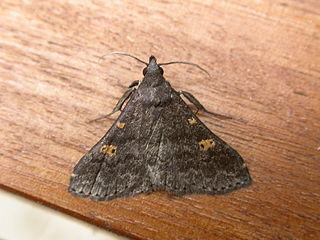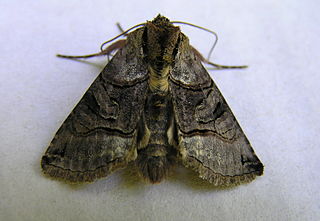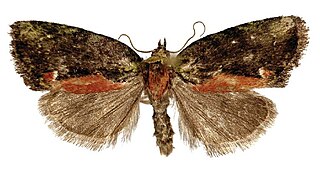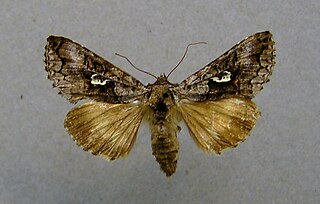
Plusiinae is a smallish subfamily of the moth family Noctuidae. As the Noctuidae appear to be a paraphyletic assemblage, the Plusiinae may eventually be raised to family status.

Victrix is a genus of moths in the family Noctuidae described by Otto Staudinger in 1879. It may be synonymous with the genus Moureia.

Naarda is a large genus of erebid moths currently encompassing 108 species. Initially identified by Francis Walker in 1866, it is in the family Erebidae. Somewhat ruddy in appearance, this genus is distinguishable for its generally slender thorax and abdomen, and straight, porrect labial palpi. Most species are a light tan color, but shading can reach as deep as a charcoal, with muddy yellow, conspicuous reniform, orbicular stigmata featured on the forewings, sometimes reflected bilaterally superior.

Heliothis peltigera, also known as the bordered straw, is a species of moth of the family Noctuidae.

Abrostola is a genus of moths of the family Noctuidae.

Chrysodeixis is a genus of moths of the family Noctuidae described by Jacob Hübner in 1821.

Ctenoplusia is a genus of moths of the family Noctuidae.

Lacanobia is a genus of moths in the family Noctuidae.
Lophomilia is a genus of moths of the family Erebidae. The genus was described by Warren in 1913.

Lygephila is a genus of moths in the family Erebidae. The genus was erected by Gustaf Johan Billberg in 1820.

Mniotype is a genus of moths of the family Noctuidae.

Stenoloba is an East Asian genus of moths of the family Noctuidae. The genus was described by Staudinger in 1892.

Syngrapha is a genus of moths of the family Noctuidae.

Thysanoplusia is a genus of moths of the family Noctuidae described by Taira Ichinosé in 1973.

Syngrapha interrogationis, the scarce silver Y, is a moth of the family Noctuidae. It is found in northern part of the world including Alaska, Canada, Iceland, Europe, Siberia, the Pacific Northwest region of the United States, and Northeast Asia.

Thysanoplusia daubei is a moth of the family Noctuidae. It is found in North and East Africa, Southern Europe, Arabia, Turkey, Southern Iran to the Himalayas, India, Indochina, China, Japan and Taiwan.

Globia algae, the rush wainscot, is a moth of the family Noctuidae. The species was first described by Eugenius Johann Christoph Esper in 1789. It is found in central and southern Europe, Turkey, Armenia, northern Caucasus, south-west Siberia.

Apamea rubrirena is a moth of the family Noctuidae.

Oraesia emarginata is a species of moth of the family Erebidae first described by Johan Christian Fabricius in 1794. It is found in Australia, New Caledonia, Indonesia, New Guinea, Pakistan, the Philippines, India, Sri Lanka, Sulawesi, Taiwan, China, Japan, Korea and Nepal as well as Eritrea, Ethiopia, Kenya, Namibia, Nigeria, South Africa, Tanzania, the Gambia, Uganda, Oman and Yemen.

Syngrapha devergens is a moth of the family Noctuidae. It is found in the Alps, the Tian Shan Mountains and the Altai Mountains




















